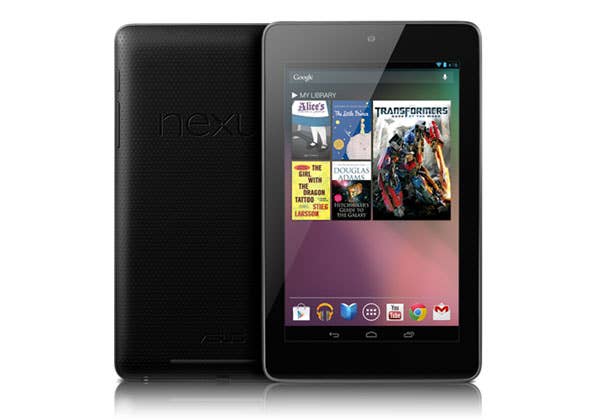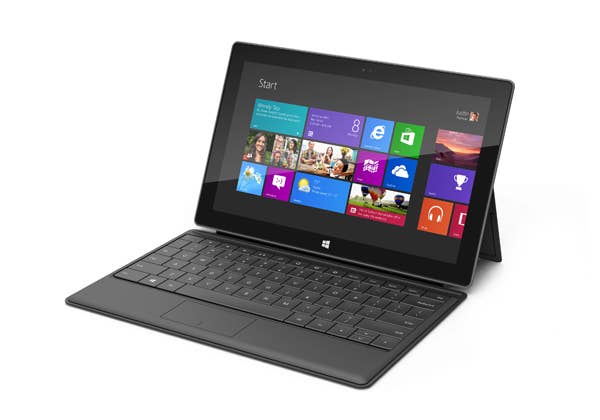Tech Focus: Tablet Wars
Digital Foundry looks at the challenges Apple faces with the arrival of the Google Nexus 7 and Microsoft Surface.
For over three years, only one tablet product has gained traction with the mainstream: Apple's phenomenal iPad. Niche challengers have come and gone, while heavyweights including RIM, Sony, Samsung and Motorola have all singularly failed to make any kind of impact on Apple's stranglehold on the market. Now the Cupertino giant's closest rivals have finally woken up: Microsoft and Google are both rolling out the big guns with the upcoming releases of Surface and the Nexus 7.
There's little doubt that the iPad has defined the prerequisites of a mainstream-focused tablet, and to a certain extent both of these challengers are "me too" products. Each is based on the notions of a slick, user-friendly interface, capacitive touch-screens, and low-power integrated processors paired with large batteries to provide stamina in the 8-10 hour range - the defining elements of the iPad.
However, the differences between the products are interesting in that they illustrate exactly where Apple's challengers believe its weaknesses are: the question really is whether these perceived deficiencies are enough to really open up the market.
"The likes of RIM, Sony and Samsung have all failed to effectively challenge the iPad phenomenon. Now Apple's rivals have finally woken up - but can Microsoft Surface and the Google Nexus 7 compete?"
Google's approach is intriguing: with the Nexus 7, it has staked a claim to the value end of the market, looking to offer an approximate high-end experience in a package that is a fraction of the cost of the $500 top-end "New iPad" and half the price of the $400 iPad 2. Google's tablet miniaturises the experience onto a 7-inch, IPS 1280x800 screen that cuts some corners on brightness and colour reproduction but crams a lot of pixels into a small enough area to give something approaching Retina fidelity.
Elsewhere, all the core functionality you would expect from a tablet is present and correct, while more extravagant elements that have somehow become a standard on more expensive tablets have been stripped out - so there is no rear-mounted camera for example, no HDMI output - and only a single microUSB port.
Only 8GB and 16GB SKUs are planned and there is no support at all for cellular connectivity - Google's strategy seems to be in attracting the value-conscious and tablet newcomers, and perhaps convince them to upgrade when the time is right to another Android tablet. The Nexus 7 is produced by Asus, and the Nexus 7 comes across to a certain extent as a "gateway" product to the firm's more expensive offerings.
Microsoft's Surface has no pretensions in masking the "me too" elements of its design. Although it has opted for a widescreen display over the iPad's 4:3 screen, there's little doubt that it aims for the premium side of the market in exactly the same way as the Apple tablet, with its high-end magnesium finish and weight/dimension advantages over the current generation iPad. At its presentation for the device, a huge amount of focus was put into the kickstand - curious, as it suggests that Microsoft believes that a great deal of tablet-time is spent near some kind of static, flat surface that it can rest upon.

But the true point of difference that Microsoft is banking on is Windows 8 and everything it represents: specifically functionality, productivity and the ubiquity of the OS on other devices. A fully featured USB port means that virtually any peripheral can be run from the tablet - printers, storage drives - with standard Windows drivers being used to run them. The Touch and Type covers in combination with Microsoft Office potentially offer Surface RT a level of functionality well beyond what the iPad offers, in a pleasingly integrated manner.
Traditional, native x86 Windows programs won't work on the Surface RT however, and therein lies one of Microsoft's biggest challenges: building its own version of Apple's walled garden app store. Having failed comprehensively with Windows Phone 7, Microsoft desperately needs to create transaction infrastructure that rivals Google Play and iTunes. Just a couple of months from launch, there are still some question marks over the Metro marketplace and the level of support it will attract.
"A merging or convergence between OSX and iOS has been mooted for years now, but Microsoft has got their first by rolling out Windows 8 simultaneously on computer and mobile platforms."
Of course, the advantage Microsoft has is the sheer proliferation of Windows on traditional computers and laptops. The next version of the desktop OS features support for Metro apps, along with the compatibility with traditional x86 binaries missing from the RT tablet. The same core kernel is deployed on all devices, be they tablet, smartphone, laptop or desktop - representing an unprecedented level of convergence.
In this respect, Microsoft is well ahead of Apple: there have been rumours for some time that iOS and OSX would merge, or overlap more overtly at some point, but Windows 8 manages to pull that off successfully in the here and now. It's a state of affairs reflected in the Surface hardware too. While the RT tablet has access to Metro apps only, the Surface Pro - running Intel ultra-low voltage CPUs - is effectively an Ultrabook class PC squeezed down into a tablet form factor just a little heavier and thicker than the New iPad. It supports Metro while running traditional apps and games (albeit less demanding ones owing to the Intel integrated GPU). Most tantalising of all, the integration of powerful x86 hardware into the tablet form factor is hugely compelling - in a stroke, Microsoft not only provides an intriguing alternative to the iPad, but it is also taking on the Macbook Air too.
All of which suggests that maybe - just maybe - Apple will be facing its first serious challenges: Google with its value approach on one side and a direct attack from the full power of the Windows brand on the other. It'll certainly make life interesting - definitely from a tech writer's point of view - but it's difficult to place any kind of bet against the company that has essentially defined this fledgling market. Apple wins not only through its combination of a power brand, product quality and a beautiful user interface, but also in terms of the most crucial factor of all: content.
In this regard, Android still falls short, while Windows 8 - in terms of Metro apps, at least - remains a completely unknown quantity. From a gaming perspective, Apple has invested significantly in creating the most attractive ecosystem for games developers. Market fragmentation is an issue (New iPad is immensely more powerful than the original, 4S vs. 3GS likewise), but it's nowhere near as bad as Android where virtually every hardware manufacturer rolls their own combination of processor, RAM, GPU and display, and where take-up of the latest version of the OS is minimal, to say the least. Perhaps the Nexus 7 can change that.

In terms of our industry, there's also the small matter of Apple having invested most heavily in the most games-capable hardware. The PowerVR SGX543 in the iPad 2 still comfortably outpaces Tegra 3 in most GPU applications, and when comparing the size of the silicon that's no real surprise at all. With a 163mm2 die-size, the New iPad's main processor occupies twice the space of Tegra 3 and even iPad 2's processor remains a good 50 per cent larger.
The Nexus 7 uses a lower-binned version of the Tegra 3 chip that can't run quite as quickly as the top-end version found in the Transformer Prime, but Surface appears to be using a revised Tegra 3+ - a more powerful version of the chip that hasn't been benchmarked as of yet. NVIDIA describes it as a significant bump, but it will take more than that to get anywhere near top-end PowerVR performance. Apple's investment in this hardware obviously makes iPad more expensive, but it's a direct investment into the quality of the slick user-interface and the gaming credentials of the platform.
It's also difficult to avoid the conclusion that Apple's competitors are still playing catch-up, and in this regard, while Microsoft is bringing something tangibly new to the table with Windows integration, it still has some clear UI weaknesses. Android 4.1's "Project Butter" finally sees Google addressing the stuttering interface issues that have plagued its OS, but there are still some serious question marks over just how intuitive Microsoft's Metro interface actually is - especially so in the desktop iteration. Not only that, but the OS actually seemed to crash during the media playback demo during the Surface keynote, and even the creators of the device appeared to be having issues navigating around the interface - something that doesn't fill us with confidence.
"The same production process that makes next-gen consoles possible is coming to mobile. The next iPad should see a huge leap in graphical power. Apple is obviously ready - but what about Google and Microsoft?"
There's also the fact that Apple remains the trailblazer in the tablet sector. It has the cash, the will, the infrastructure and the guaranteed launch success - not to mention the software support - to drive the products forward into territory that its competitors fear to tread. Take the New iPad for example - it is defined by its Retina screen, which in turn required enormous battery and processor upgrades. Remarkably, Apple's latest tablet has battery capacity around 20 per cent higher than that of the 11-inch Macbook Air. In short, the firm targeted the display upgrade as the defining element of its third-gen tablet and moved heaven and earth to make it happen.
In a market sector defined to a great extent by technological advancement, it's hard to imagine any of Apple's rivals pushing back new frontiers with anything like the same kind of zeal - and there is perhaps a sense that, as games machines at least, there is some missed potential here. Even though Tegra 3 lacks 3D performance compared to the IMG tech in the iPad, it is clearly capable enough for current mobile gaming - but next year, everything changes. The same 28nm chip production technology that makes the next-gen consoles possible, and that has made NVIDIA's Kepler GPUs so powerful and efficient, will also reach mainstream mobile production.
Tegra 3 will be superseded by NVIDIA's Project Wayne - said to offer a whole new level of graphical performance, offering a real challenge to performance leaders IMG. At the higher end of the scale, Intel's next CPU - which could well end up in a second-gen Surface Pro - is believed to offer a 2x to 3x graphical boost over the current HD4000 tech. Based on our recent integrated graphics testing, conceivably we could see Battlefield 3 and Crysis 2 running at 60 frames per second - on a tablet.
But it's almost certain that Apple will take point on this new gaming revolution. Next year's iPad - hotly tipped to incorporate the new ARM Cortex A15 architecture and IMG's PowerVR Rogue chipset sees a leap in performance that should see the tablet's raw gaming potential reach and even exceed current-gen console levels, with the added benefit of DirectX 11-level GPU features. At that point, the platform becomes a viable target for AAA games development. Remember the first time you saw Infinity Blade on mobile? That is just a hint of where the platform could be heading - and while Google and Microsoft race to catch up with the current-gen iPad, once again it'll be Apple that pushes the game to the next level.

